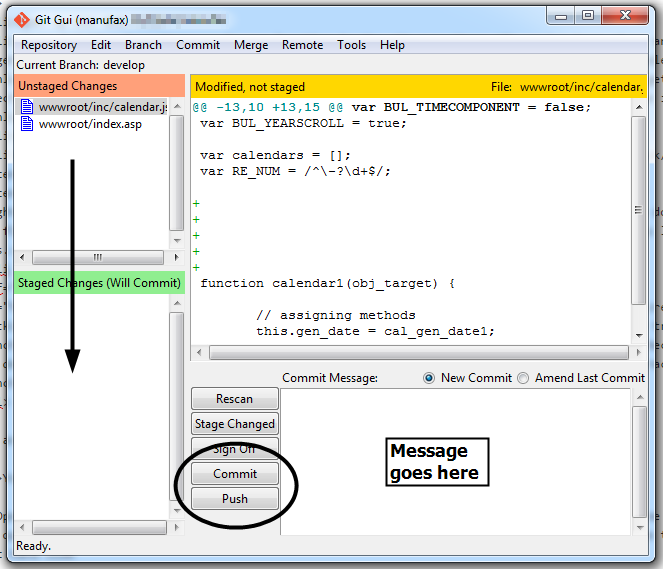

- #COMMIT AND PUSH TO A DIFFERENT BRANCH NOT MASTER GIT UPDATE#
- #COMMIT AND PUSH TO A DIFFERENT BRANCH NOT MASTER GIT CODE#
The downside of this approach is that all developers who already have a local copy of the master branch will need to perform a git reset -hard.įorce pushing to the master branch might fail if you use GitLab’s “Protected Branches” feature. While its nice to be consistent, we really havent shortened. This solution may be appropriate in your case if you have a small number of other branches and/or other developers. So, we can use HEAD as a way to keep the git push command consistent across different branches. Warning: this erases all commits from the master branch that are not also in the develop branch.

Using the -f flag, your previous master is completely overwritten with develop, including its history. Force PushingĪ more brutal alternative is to force push the develop branch under a different name: git push -f origin develop:master The downside is that this merge might fail if your develop and master have diverged to a large degree. This method’s advantage is that you get a clean merge commit and other developers using those two branches are less likely to experience problems when merging their feature branches. The resulting master should now contain the contents of your previous develop and ignore all changes in master. You can use the following commands to merge develop into master using the ‘ours’ merge strategy: git checkout develop One way out of this dilemma is to completely replace master with the current develop. We will need to use the git stash command to commit these changes to the testing branch. Most of those reasons suggest bad practices, but such a situation may also arise due to changes introduced into your git workflow or deployment process.
#COMMIT AND PUSH TO A DIFFERENT BRANCH NOT MASTER GIT CODE#
You may also have a develop branch which contains code changes that are not ready for production deployment yet.įor some reason or another, you may end up in a situation where your develop has changed so much that you can no longer easily merge it into master. So, the entire statement " git push origin master" pushed the local content on the master branch of the remote location.In many git workflows, all changes to your code should eventually end up in the master branch. Generally, the term origin stands for the remote repository, and master is considered as the main branch. It's always a good idea to use git status to see what branch you are on before pushing to the remote. So, if you are checked out to the main branch when you execute git push, then only the main branch will be updated. When you have multiple branches and directory, then this command assists you in determining your main branch and repository. By default, git push only updates the corresponding branch on the remote. Git push origin master is a special command-line utility that specifies the remote branch and directory. It is very useful if you are going to push the branch for the first time. u: It creates an upstream tracking connection.

delete: It deletes the specified branch.
#COMMIT AND PUSH TO A DIFFERENT BRANCH NOT MASTER GIT UPDATE#
It does all this except originally update the repository. The deleted refs will be removed from the remote end. It can be force updated on the remote end. Updated or Newly created local refs will be pushed to the remote end. mirror: It is used to mirror the repository to the remote. Means, if you have a remote branch say demo, if this branch does not exist locally, then it will be removed. prune: It removes the remote branches that do not have a local counterpart. all: The word "all" stands for all branches. : It specifies the destination ref to update source object. It can be either a URL or the name of a remote repository. We havent moved to the new branch, we are still on the master branch and. : The repository is the destination of a push operation. In Git, branches are simply a group of commits (or even just a single commit). Some options are as follows under push tags. Push command supports many additional options.


 0 kommentar(er)
0 kommentar(er)
